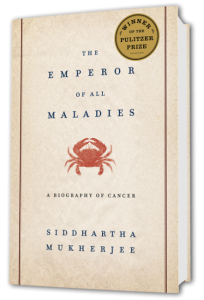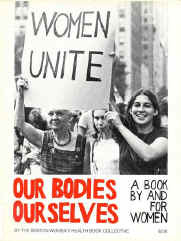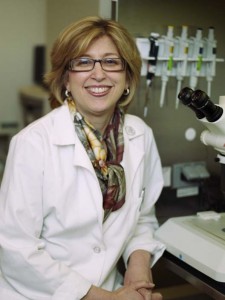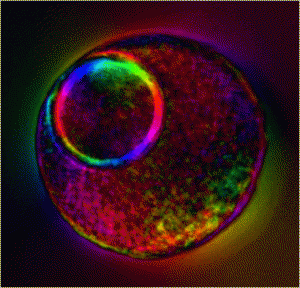COLLEGE FEMINISMS: Oncofeminism
By Guest Contributor on April 20, 2015By Petra Jans
Science has always been my calling, but it was not until I started studying feminism at Colorado College that I began to see the ways in which science was conflicting with my being a woman. Though I am now an aspiring physician scientist drawn to cancer research, studying feminism has revealed how science and medicine are deeply entrenched in sexism and patriarchy. Hence, I hope to not just join the fight against cancer, but be a critical part of changing the way we carry out the fight.
Cancer is defined as the uncontrolled growth of abnormal or malignant cells that are capable of spreading to distant sites throughout the body. Though cancer, which affects millions of Americans each year, is often grouped as one disease, it is many different diseases classified by the type of tissue from which the malignant cells originated. Cancer begins in our own cells where, over time, mutations have occurred, changing the genetic material and allowing the cells to escape the restraints of normal growth. It is a fascinating disease because it is one in which the cells of our own bodies seem to turn against us, exploiting us until there is no tissue left un-colonized. According to oncologist Siddhartha Mukherjee, “To confront cancer is to encounter a parallel species, one perhaps more adapted to survival than even we are” (pp. 39). Mukherjee weaves an intricate history of cancer and its treatment, and uncovers feminist issues, which beckon me to dig deeper into this cause to which I am hoping to dedicate my life.
spreading to distant sites throughout the body. Though cancer, which affects millions of Americans each year, is often grouped as one disease, it is many different diseases classified by the type of tissue from which the malignant cells originated. Cancer begins in our own cells where, over time, mutations have occurred, changing the genetic material and allowing the cells to escape the restraints of normal growth. It is a fascinating disease because it is one in which the cells of our own bodies seem to turn against us, exploiting us until there is no tissue left un-colonized. According to oncologist Siddhartha Mukherjee, “To confront cancer is to encounter a parallel species, one perhaps more adapted to survival than even we are” (pp. 39). Mukherjee weaves an intricate history of cancer and its treatment, and uncovers feminist issues, which beckon me to dig deeper into this cause to which I am hoping to dedicate my life.

A sketch of the radical mastectomy from William Stewart Halsted Surgical Papers
When I first became infatuated with cancer biology, I could not imagine anything unjust about the war on cancer, except maybe the cancer itself. Not until some recent digging did it become clear that, even in our recent history, women’s bodies have been a central battleground in this war. According to James Olson, at the end of the 19th century, Dr. William Halsted took advantage of recent gains in aseptic surgical techniques, anesthesia, and pathology to develop the radical mastectomy (pp. 58). The radical mastectomy became the hallmark of breast cancer treatment, and Halsted became a medical hero. In his procedure, the entire breast, axillary lymph nodes, and chest muscles were cut away in a single motion with the hope of removing every trace of cancer before it was able to travel or metastasize to distant sites and become a systemic and fatal disease. However, Halsted’s radical mastectomy left women with concave chests, and for some this meant brutally disfigured. Simultaneously at this historical point, the world of medicine was transitioning from domestic medicine delivered primarily by women, to professional, academic medicine, which was male-dominated. As medicine became more grounded in science it suffered from depersonalization, and breast cancer patients became the “scientific objects” of surgeons, who were only keen on improving survival rates (Olson, pp. 64).
The radical mastectomy’s dominance over most of the 20th century is an example of how science can turn into dogma−this is what makes it so concerning to feminists. The procedure was based on a theory that breast cancer started as a local disease, an isolated tumor, and only at a certain point did malignant cells begin to break off and spread beyond the initial site, metastasizing, to become a systemic disease and no longer curable. Thus, if all of the tissue containing and surrounding the tumor could be removed, the chance of the cancer spreading would be significantly reduced. Unfortunately, this theory turned out not to be true. As, in many cases, cancer is already a systemic disease long before distant metastases are visibly detected. In the early 1900s radiotherapy became another form of cancer treatment. In 1935, British physician Geoffrey Keynes performed a study comparing breast cancer patients treated with radical mastectomies to those treated with simple mastectomies followed by radiation, which was a much less invasive procedure. He found no difference in survival rates fifteen years later. Despite his scientific reason, accompanied by a few others over the years, it would not be until the 1970s, when breast cancer became more visible to the public, that the Halsted radical mastectomy’s reign over breast cancer treatment would come to an end.
As feminists revealed, women were the “guinea pigs” of the glorified medical establishment, and surgeons, who remain predominantly male even today, were the valiant heroes of the “war on cancer.” Not only did women fight against the radical mastectomy, but many, lead by Rose Kushner, also advocated against the common practice of combining breast biopsies and mastectomies into one procedure. It was common practice that if a surgeon found cancer, they would remove it without waking the patient. The patient would go to sleep not knowing if she had cancer and could wake up with her entire breast gone. In this practice, women had little to no role in the decisions about their bodies. Despite the work of activists, and the

The first edition of the book, “Our Bodies, Ourselves” by the Boston’s Women’s Health Book Collective in 1973
status of breast cancer as one of the most visible diseases in society, I fear the errors and hubris that cultivated the radical mastectomy to its peak in the 1950s did not disappear with the death of the procedure. Feminists recognized the paternalistic power relations of the physician-patient relationship, especially between male physicians and female patients. With the production of feminist texts like Our Bodies, Ourselves, women are encouraged to take charge of their own health and question the authority of the medical establishment, and demand multiple opinions as well as the pros and cons of each treatment. When it comes to cancer, the scientific community does not have all the answers, nor the “right” answers for people. Thus, as the holders of their bodily knowledge, women have an important role to play in partnership with their doctor, where their insights are valued just as much as those of the physician.
Care for cancer patients, however, does not end with the final dose of chemotherapy or the last stitch of a surgery to remove a tumor. There are many physical consequences of the treatment alone, like the hair-loss that everyone pictures when they think of cancer patients, not to mention the sometimes dangerously low white blood cell counts. And, we cannot forget the psychological and social effects as well. In addition to all of the cancer awareness organizations, there exists a large market of cancer support groups and countless literatures written by cancer survivors that offer words of encouragement and hope for those who are negotiating their experience with cancer. One of the most prominent struggles these authors confront is the assault that breast cancer makes on their identities and the instability of their identities, as women and as people. These literatures detail what it means to come to terms with what seems like an attack from within and the feeling of fragmentation when a body part must be amputated.

Estee Lauder breast cancer awareness advertisement, which raises questions about misrepresentation of survivors, body politics, and marketing agendas. What are the ethics of breast cancer awareness campaigns?
For example, in Diane Price Herndl’s feminist analysis of breast cancer literatures and memoirs, she argues that instead of embracing the transitory nature of identity and life, the narratives tend to focus on a single identity: survivor. Though these kinds of narratives create an important community for women with breast cancer that surely was not present thirty years ago, Price Herndl argues that it is but a small community that encourages normalization and “certainly does not move out to embrace the disability movement and its challenge to the idea that there is only one form of healthy embodiment” (pp. 241). There is so much inequity in the way we discuss and handle illness in this country. Breast cancer texts, as well as the mainstream breast cancer movement, do little to challenge the ablest norms of health, women, and patriarchal science.
Along these lines, Barbara Ehrenreich tells her own breast cancer story in “Welcome to Cancerland,” which offers some compelling critiques of the breast cancer movement that she cunningly renames the “breast cancer cult.” For example, the continued emphasis on mammograms, a technology that many studies have shown does very little to improve survival, simply extends the length of time that a woman is aware of having breast cancer.
America’s breast-cancer cult can be judged as an outbreak of mass delusion, celebrating survivorhood by downplaying mortality and promoting obedience to medical protocols known to have limited efficacy. And although we may imagine ourselves to be well past the era of patriarchal medicine, obedience is the message behind the infantilizing theme in breast-cancer culture, as represented by the teddy bears, the crayons, and the prevailing pinkness (Ehrenreich, 2001).
Peggy Orenstein, in “Our Feel-Good War on Breast Cancer,” also takes a critical stance on annual mammograms after conceding, “I used to believe that a mammogram saved my life.” Mammography is a screening tool based on a similar assumption that led to the radical mastectomy: early detection and early removal of the tumor are necessary to catch the cancer before it spreads. But as scientists have learned

Gayle Sulik‘s new book “Pink Ribbon Blues” offers another example of a feminist critique of the breast cancer movement.
more recently, the course of breast cancer from a local tumor to metastatic disease is far from uniform and is rather unpredictable. Some of the worst forms of cancer have often metastasized well before they are detectable by a mammogram, while other forms may never metastasize or they grow so slowly that they are equally treatable even after being found years later without a mammogram — meaning by the woman herself or by a physical exam. What this amounts to, Orenstein argues, is an unnecessary amount of over-diagnosis, putting many women through treatments that they may not have needed. Many of the women receiving what could be considered unnecessary treatment have the diagnosis of ductal carcinoma in situ (DCIS), a pre-malignant abnormality of the milk duct, which may or may not progress to invasive cancer. Eliot Marshall discusses the problems with the DCIS diagnosis and the unwarranted psychological and physical damage it may be causing women. These issues surrounding DCIS are a consequence of the overuse of mammograms. Though annual mammograms can hardly be considered as traumatic as the radical mastectomy, their logic is systemic because the result is that women’s bodies become the objects of science and medicine and are often traumatized.

Dr. Teresa Woodruff in her Northwestern University Lab.
It has been unsettling to learn of the injustices woven into the history of cancer, but it motivates me to play a part in the changes that need to occur in the field of medicine and science. Because science necessitates change through new technologies and new discoveries, scientists and physicians must continue to question the “accepted” and challenge the status quo. What good is research if you always ask the same questions, always approaching the problem from the same point of view? There are many more women in science now than a century ago, but I often wonder how much has changed in the domineering masculine mentality of the science community. So, I “Googled” medical feminism, and found a medical student’s blog mentioning women who were changing medicine, which included Dr. Teresa K. Woodruff at Northwestern University. I watched Dr. Woodruff’s TEDx talk on oncofertility, and the more I read about her work, the more inspired I became. Dr. Woodruff’s research has revealed that significantly fewer young female cancer patients have the option to preserve their fertility before the damage done by chemotherapy than their male counterparts. This is a significant insight on the persistence of patriarchal science because it reflects a gender bias in the way cancer treatments and fertility are approached by physicians. Additionally, it reveals a gender bias in what scientists actually know about fertility preservation for cancer patients, which cannot simply be accounted for by the relative “complexity” of the female reproductive system. Woodruff’s work seeks to eliminate this gender bias in fertility preservation for cancer patients, as well as the gender bias that exists in much of basic science and medical research.
To do so, Dr. Woodruff has founded and directs the Oncofertility Consortium. The Consortium takes an interdisciplinary approach, bringing together oncologists and reproductive scientists, to increase our knowledge about the effect of chemotherapy and radiation on ovarian development, and improve methods of effectively preserving ovarian tissue for young women with cancer, among many other projects; it provides resources and options to patients and practicing health professionals. Dr. Woodruff’s research contributes to the ending the gender bias in science by advocating for the importance of recognizing and investigating sex differences in medical research. Additionally, she created the Women’s Health Research Institute at Northwestern University to promote interdisciplinary research and provide mentorship for young women in the biomedical sciences, as well as patient outreach. While these are all positive changes in addressing women’s issues in health and science, there is more to be done in the dismantling of gender inequality and health disparities.
As Dorothy Roberts argues, there are many shortcomings of the oncofertilty approach, particularly the need to address the social and economic issues surrounding fertility preservation. While an important implication of oncofertility is its protection of a woman’s reproductive autonomy, Roberts argues that more could be done to challenge reproductive norms that place more value on genetically related than adopted children. This would mean that oncofertility centers should work to remove the many barriers that prevent cancer survivors from adopting children. Roberts also reveals how oncofertility fits neatly into our social hierarchies of dominant gender roles, which emphasize the importance of motherhood in a woman’s life.
Does the desire to preserve this option and the distress from losing it [the ability to have a child] stem in part from a gender injustice? [or perhaps it is due to] …the unjust expectation that all women will become mothers, and the stigma of infertility (Roberts, 781).
Furthermore, economic barriers prevent many women from even accessing these new fertility preservation technologies. Instead of reproducing the patriarchal logic, Roberts argues for a focus on the reasons for fertility loss and ways we can prevent it as “a systemic change, rather than expensive technological interventions” (pp. 798).
Needless to say, solving these injustices in women’s health, in cancer and other diseases, cannot be done by one scientist, or scientists alone, but will require continued effort from feminist advocates in all areas of society. Woodruff, herself, seems to recognize the value of a more systemic solution, and she makes a hopeful prediction that the field of oncofertility will be obsolete in twenty years, believing that we are well on our way to developing new cancer therapeutics that will not cause as much damage to the reproductive system, and thus prevent the problem in the first place (Science 2034).
I think the social history of cancer has an important message to deliver, especially to young aspiring physicians and biomedical scientists. As we become a part of the ever-growing medical establishment, we have a lot of power and will have to choose: do we want to continue to practice medicine and science the way it has always been done? Or will we dare to question the status quo, consider new perspectives and complexities, and challenge our field to create a more just and livable society?
************************
 Petra Jans is a senior at Colorado College majoring in Biochemistry with a minor in Feminist and Gender Studies. Originally from England, she has called Colorado home since 2001. She enjoys hiking, singing, traveling, and visiting her family in Belgium. After graduation, she will be attending medical school and working towards her goal of becoming a physician scientist.
Petra Jans is a senior at Colorado College majoring in Biochemistry with a minor in Feminist and Gender Studies. Originally from England, she has called Colorado home since 2001. She enjoys hiking, singing, traveling, and visiting her family in Belgium. After graduation, she will be attending medical school and working towards her goal of becoming a physician scientist.
All Content ©2016 The Feminist Wire All Rights Reserved





2 Comments